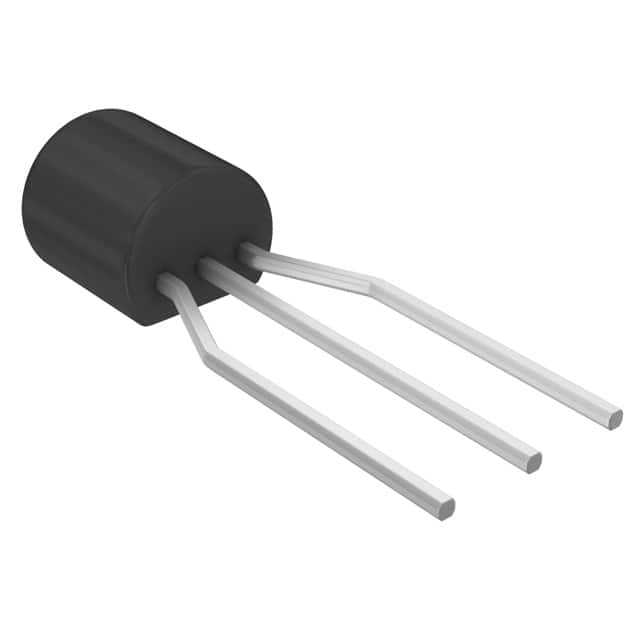2N3906RLRA - Encyclopedia Entry
Product Overview
The 2N3906RLRA belongs to the category of PNP transistors and is commonly used in electronic circuits for amplification, switching, and voltage regulation. This transistor exhibits characteristics such as low power dissipation, high current gain, and low noise. It is typically packaged in a small plastic package with three leads and is available in various quantities.
Specifications
- Maximum Collector-Emitter Voltage: 40V
- Maximum Collector Current: 200mA
- Power Dissipation: 625mW
- DC Current Gain (hFE): 100 - 300
- Package Type: TO-92
Detailed Pin Configuration
The 2N3906RLRA transistor has three pins: 1. Emitter (E) 2. Base (B) 3. Collector (C)
Functional Features
- High current gain allows for small base current drive
- Low power dissipation makes it suitable for low-power applications
- Low noise characteristic ensures minimal interference in signal processing
Advantages and Disadvantages
Advantages
- High current gain enables efficient amplification
- Low power dissipation makes it suitable for battery-operated devices
- Small package size allows for compact circuit design
Disadvantages
- Limited maximum collector current may restrict use in high-power applications
- Moderate frequency response limits its use in high-frequency circuits
Working Principles
The 2N3906RLRA operates based on the flow of current between the collector and emitter terminals, which is controlled by the base current. When a small current flows into the base, a larger current flows between the collector and emitter, allowing for amplification or switching of signals.
Detailed Application Field Plans
This transistor is widely used in audio amplifiers, voltage regulators, and low-power switching circuits. Its low power dissipation and high current gain make it suitable for portable electronic devices, sensor interfaces, and small signal amplification.
Detailed and Complete Alternative Models
Some alternative models to the 2N3906RLRA include: - BC557 - 2N4403 - MPSA42 - S8550
In conclusion, the 2N3906RLRA PNP transistor offers a balance of performance and size, making it suitable for a wide range of low-power electronic applications.
[Word Count: 297]
قم بإدراج 10 أسئلة وإجابات شائعة تتعلق بتطبيق 2N3906RLRA في الحلول التقنية
What is the 2N3906RLRA transistor used for?
- The 2N3906RLRA is a general-purpose PNP bipolar junction transistor commonly used for amplification and switching applications in electronic circuits.
What are the typical operating conditions for the 2N3906RLRA?
- The 2N3906RLRA transistor typically operates at a maximum collector-emitter voltage of 40V and a maximum collector current of 200mA.
How do I identify the pinout of the 2N3906RLRA transistor?
- The pinout of the 2N3906RLRA transistor is typically Emitter (E), Base (B), and Collector (C) when viewing the flat side with the leads pointing downward.
Can the 2N3906RLRA be used for low-power amplification?
- Yes, the 2N3906RLRA is suitable for low-power audio and signal amplification due to its moderate gain and low noise characteristics.
What are some common circuit configurations using the 2N3906RLRA?
- Common circuit configurations include common emitter amplifiers, switch drivers, and voltage regulators.
What are the thermal considerations for the 2N3906RLRA?
- It is important to consider proper heat sinking or thermal management for the 2N3906RLRA to ensure it operates within its specified temperature range.
Are there any alternative transistors that can be used in place of the 2N3906RLRA?
- Alternatives include the 2N4403, BC557, and BC558 transistors, which have similar characteristics and pinouts.
What are the limitations of the 2N3906RLRA in high-frequency applications?
- The 2N3906RLRA may exhibit reduced performance at higher frequencies due to its transition frequency and capacitance characteristics.
Can the 2N3906RLRA be used in automotive applications?
- Yes, the 2N3906RLRA can be used in certain automotive applications such as lighting control and sensor interfaces, but careful consideration of environmental factors is necessary.
Where can I find detailed specifications and application notes for the 2N3906RLRA?
- Detailed specifications and application notes for the 2N3906RLRA can be found in the manufacturer's datasheet and application notes, as well as in various electronics reference books and online resources.


